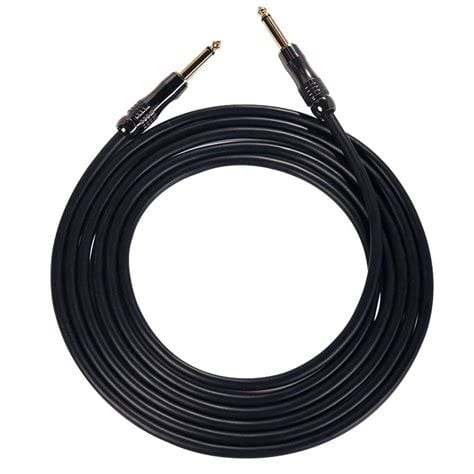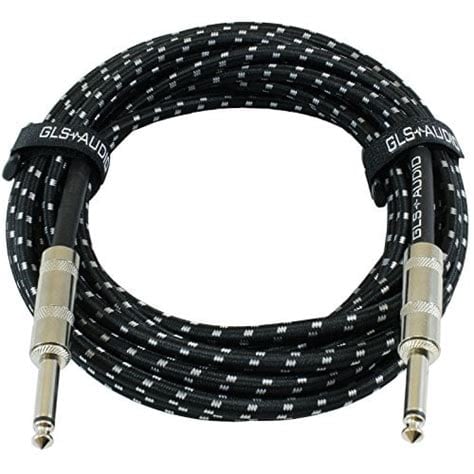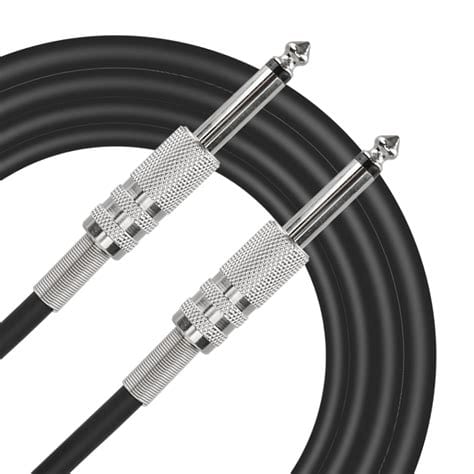Shielding: Blocking Out Noise and Interference
One of the most important features of a high-quality guitar cable is its shielding. Shielding refers to the cable’s ability to block out external noise and interference that can degrade your signal. There are a few main types of shielding used in guitar cables:
| Shielding Type | Description | Effectiveness |
|---|---|---|
| Braided Copper | Woven copper strands surround the insulation to provide shielding | Good |
| Serve Shield | Copper wire spiraled around the insulation to create a shield | Better |
| Foil Shield | Mylar-backed aluminum foil wrapped around the insulation | Best |
Foil shielding, often combined with a braided copper shield, offers the highest level of protection against electromagnetic interference (EMI) and radio frequency interference (RFI). This ensures your guitar signal remains clean and free from unwanted noise.
How to Test Cable Shielding
To test your cable’s shielding effectiveness, try this simple trick:
- Plug one end of the cable into your amp
- Turn up the volume on your amp
- Hold the other end of the cable near sources of interference (e.g., cell phones, computer monitors)
- Listen for any added noise or buzz
A well-shielded cable should minimize or eliminate any extra noise when exposed to these sources.
Conductor Material: Copper vs. Silver
The conductor material in your guitar cable can also impact your sound. The two most common materials used are copper and silver.
Copper Conductors
Copper is the most widely used conductor material in guitar cables due to its excellent electrical conductivity and affordability. There are a few different types of copper used:
- Oxygen-Free Copper (OFC): Purified to reduce oxygen content, which can improve conductivity and durability
- Linear-Crystal Oxygen-Free Copper (LC-OFC): Further refined to align copper crystals, claimed to enhance clarity and frequency response
- Electrolytic-Tough-Pitch Copper (ETP): Standard copper, less expensive but more prone to oxidation over time
Silver Conductors
Silver is an even better conductor than copper, but it comes at a higher cost. Some high-end guitar cables use silver-plated copper conductors, which offer a balance of silver’s superior conductivity and copper’s affordability. Silver is said to provide a brighter, more detailed sound compared to copper.

Gauge: Balancing Tone and Durability
The gauge of a guitar cable refers to the thickness of the conductor wire, typically measured in American Wire Gauge (AWG). Common gauges for guitar cables range from 20 AWG (thicker) to 28 AWG (thinner).
| Gauge | Pros | Cons |
|---|---|---|
| Thicker (20-22 AWG) | More durable, less prone to handling noise | Stiffer, less flexible |
| Thinner (24-28 AWG) | More flexible, easier to handle | Less durable, more prone to handling noise |
Thicker cables generally offer better signal transfer and durability, while thinner cables are more flexible and easier to coil. Ultimately, the best gauge for you depends on your preferences and playing style.

Capacitance: Preserving High Frequencies
Capacitance is a measure of a cable’s ability to store an electrical charge, which can lead to a loss of high frequencies in your guitar signal. The lower the capacitance, the better the cable is at preserving your guitar’s high-end clarity and detail.
Capacitance is measured in picofarads per foot (pF/ft). Look for cables with a capacitance of 30 pF/ft or lower for optimal high-frequency response.

Connector Quality: Ensuring Reliable Connections
The connectors on your guitar cable are just as important as the cable itself. Low-quality connectors can lead to poor connections, signal loss, and even damage to your guitar or amp jacks.
Look for cables with high-quality connectors featuring:
- Gold-plated contacts for corrosion resistance and optimal conductivity
- Sturdy housings (e.g., metal or high-grade plastic) for durability
- Strain relief to prevent damage to the cable at the connector joint
Some popular high-quality connector brands include Neutrik, Switchcraft, and Amphenol.
Cable Length: Finding the Sweet Spot
The length of your guitar cable can also affect your tone. In general, shorter cables (under 18 feet) are recommended for the best signal quality. Longer cables can cause high-frequency loss and increased susceptibility to noise and interference.
However, your ideal cable length ultimately depends on your stage setup and performance needs. If you need to move around a lot, a longer cable (25-30 feet) may be necessary. Just be aware of the potential trade-offs in tone and noise.
Flexibility and Durability: Withstanding the Rigors of Performance
Finally, a great guitar cable should be both flexible and durable enough to withstand regular use and movement on stage.
Key features to look for include:
- Stranded conductor wire for flexibility and resistance to breakage
- Sturdy outer jacket material (e.g., PVC, rubber, or woven fabric) for abrasion resistance
- Reinforced connector joints with strain relief to prevent damage from pulling or twisting
Some cables even feature a coiled section near the connector to provide extra strain relief and flexibility.
FAQ
1. Are more expensive guitar cables always better?
Not necessarily. While high-end cables often use premium materials and construction techniques, the key is finding a cable with the right balance of features for your needs and budget. Focus on cables with good shielding, low capacitance, and high-quality connectors.
2. How often should I replace my guitar cables?
This depends on how frequently you use them and how well you maintain them. Inspect your cables regularly for signs of wear, such as frayed jackets, loose connectors, or kinks. If you notice any issues with sound quality or reliability, it may be time for a replacement.
3. Can I use a microphone cable for my guitar?
While microphone cables use similar components (e.g., copper conductors, shielding), they are not ideal for guitar use. Guitar cables are designed to handle the higher impedance of guitar pickups and often have lower capacitance for better high-frequency response. Stick with dedicated guitar cables for the best results.
4. Do I need a special cable for active pickups?
No, you can use the same guitar cables for both active and passive pickups. However, active pickups are less susceptible to signal loss and noise, so you may be able to get away with using longer or lower-quality cables without noticing a significant difference in sound.
5. Should I use a coiled or straight cable?
This is largely a matter of personal preference. Coiled cables can provide some extra flexibility and strain relief, but they can also be heavier and more prone to tangling. Straight cables are simpler and easier to manage, but they may put more stress on the connectors if pulled or twisted. Try both and see which you prefer.
Conclusion
Choosing the best guitar cable for your needs involves considering various factors, from shielding and conductor material to capacitance and connector quality. By understanding these key features and how they affect your tone and performance, you can select a cable that helps you sound your best on stage and in the studio.
Remember, while a high-quality cable is important, it’s just one piece of the puzzle. Your guitar, amp, pedals, and technique all play a role in shaping your sound. Invest in a good cable, but don’t forget to focus on honing your skills and dialing in your gear as well.
With the right cable and a commitment to your craft, you’ll be well on your way to achieving the guitar tone of your dreams.

No responses yet